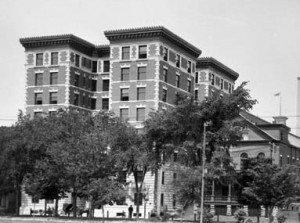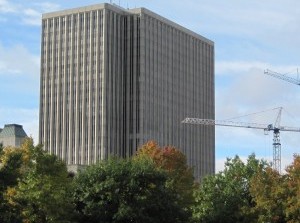It was a sumptuous apartment building, home to a famed leader, then lost to the wreckers. How many Occupy Movement protesters who gathered in Ottawa’s Confederation Park in 2011 realized they’d camped at what was once among the most prestigious addresses in the capital?
The elegant Roxborough Apartments on the northeast corner of Laurier and Elgin Street was a stroll from Parliament Hill with a prime view of the Rideau Canal. Here William Lyon Mackenzie King, Canada’s longest-serving prime minister, lived in a suite for thirteen years – “rooms filled with very sacred and memorable associations,” King confided to his diary. “The notes of beauty and refinement are all a part of what is dear to me.”
The Roxborough, crafted by Montreal architect Howard Colton Stone, was an eight-story, 82-suite landmark built of red and yellow brick and embellished with oak and marble. Rents of $40 a week included full maid service and a lavish dining lounge featuring an ancient cockatoo as mascot. It was the place of choice for Ottawa dignitaries.
King made the Roxborough his Ottawa home from his appointment as labour minister in 1909 through his triumph in the 1919 Liberal leadership campaign and first election as prime minister in ‘21.
“I am spending my last night in the rooms at the Roxborough,” King wrote January 10, 1923 as he prepared a move to the late Wilfrid Laurier’s Sandy Hill mansion. Laurier House “can scarcely ever be to me what these apartments are,” King wrote. “I feel as if I were parting with something akin to a very dear friend. I love this quiet and comfortable atmosphere.” Today the Roxborough is gone and forgotten.
No other 20th century prime minister did more than King to reshape the urban landscape of Ottawa. He initiated grand beautification schemes from the 1920s through the ‘40s;. His ideas held sway over local planners.
King gave the Ottawa Improvement Commission greater powers over construction of parks and parkways and renamed it the Federal District Commission. He was responsible for widening Elgin Street into a boulevard trod by dignitaries and royalty. He inspired creation of the National War Memorial and Confederation Square and Gatineau Park and its parkways. As prime minister he invited Paris-born planner Jacques Gréber to devise a master urban plan, unveiled in 1949, that inspired the capital’s Greenbelt but destroyed much else.
The prime minister’s beloved Roxborough Apartments became a casualty. After King’s death in 1950 it succumbed to the Gréber Plan.
The landmark was expropriated by the National Capital Commission in May 1965 and all tenants including MPs and a Supreme Court justice were evicted six months later. The building was demolished. “A disgrace,” one 89-year old tenant said of the Roxborough’s destruction. “They are pulling down the only decent apartment building in the city.”
The site was marked for construction of a national science museum but instead languished as a parking lot. In 1969 it was turned into a Confederation Park in belated observance of the nation’s centennial two years before. Today, adding further insult to King’s memory, there is no plaque commemorating the site.
By Andrew Elliott







